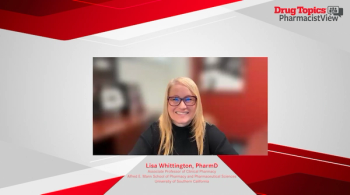
- Drug Topics June 2022
- Volume 166
- Issue 6
Improving Care Disparities for the LGBTQ+ Community
LGBTQ+ individuals can face significant hurdles when seeking health care.
Individuals who identify as a member of the LGBTQ+ community—lesbian, gay, bisexual, trans- gender, and questioning/queer— face significant health care disparities and have higher risks for depression and suicide compared with other individuals.1 Pharmacists and health care providers across the spectrum must be aware of the needs of this patient population, from which terminology to use to the health care inequalities patients face.
Pharmacy owners looking to create a comfortable environment for LGBTQ+ individuals to pick up prescriptions or obtain counseling, begin by assessing pharmacists and their staff, said Alex R. Mills, PharmD, BCACP, an assistant professor of pharmacy practice (HIV, LGBTQ+ Health) at the University of Mississippi School of Pharmacy in Jackson.
"There are opportunities for cultural humility. Assess pharmacists and their staff on their understanding of the LGBTQ+ community. Are they even aware of the challenges that are happening?” Mills told Drug Topics®. "That’s the first place to start. Then identify the resources or training they need.”
Next, evaluate the physical environment. "Can you provide an affirming environment? Is there an opportunity for your [electronic medical records] system to include pronouns?” One big challenge Mills has seen at community pharmacies is the difficulties LGBTQ+ patients face in getting their prescription if their legal name is different from their affirmed name. Take, for example, a transgender patient whose legal name was John but is now Jennifer. Their insurance may still list their legal name as John, Mills explained. “Running the prescription through insurance, that name [John] will print on their prescription packaging. Is there a way to develop systems to capture the name needed to run through insurance but the end product prints the person’s name they are using now?” he asked.
The LGBTQ+ community already faces health care disparities related to insurance and health care visits. According to the 2015 US Transgender Survey,2 25% of respondents had experienced a problem with their insurance in the past year related to being transgender, such as being denied coverage for care related to gender transition or being denied coverage for routine care. Additionally, 33% of respondents who saw a health care provider in the past year reported having at least 1 negative experience related to being transgender, including being refused treatment, verbally harassed, or physically or sexually assaulted, or having to teach the provider about transgender people to obtain appropriate care, said Mills and Kyle Melin, PharmD, MSc, BCPS, during an American Society of Health-Systems Pharmacists webinar.3 Melin is an associate professor at the University of Puerto Rico School of Pharmacy in San Juan.
Sexual and gender minorities are disproportionately affected by poverty, housing instability, and discrimination within the health care system, as well as by stigma, Mills and Melin noted. "These differences in social determinants of health can lead to health disparities and poorer health outcomes,” they added.
"Embracing the diversity of all patients and understanding where patients come from is going to affect the ability to provide good care,” Mills said. Not every patient who comes into the pharmacy to pick up their medications has had a good experience with the health care system. "That is what is preventing them from being engaged in their care. It’s recognizing that we need to paint that patient in a different picture and appreciate how the intersectionality between sexual orientation and/or gender identity affects one’s health care experience, so we can provide a holistic, person-centered approach to their health.”
Being comfortable with basic terminology used by sexual and gender minorities goes a long way toward creating a welcoming and affirming environment for LGBTQ+ patients. Some of the most important terms to know are transgender woman, someone assigned male at birth who identifies as a woman, and transgender man, someone assigned female at birth who identifies as a man.
It’s also important to understand that queer can be used by someone who doesn’t identify under just one aspect of the LGBTQ+ umbrella, and to be mindful that some individuals find this term offensive, according to Mills. Instead, allow individuals to self-disclose the term, rather than assigning it to them.
Pharmacists should also be wary of deadnaming—identifying a patient by the wrong name—or misgendering someone by using the wrong pronoun, Mills advised. Patients may even see the error themselves when they log into patient portals. "Those who are charting should know that it is very dysphoric for patients who may be using a different name, and be mindful of this during the documentation process” Mills noted.
"Stop making assumptions about people,” Mills advised. "If you make assumptions that they identify as a transgender male, for example, and assume they are romantically attracted to females, you may miss an opportunity to discuss with a high-risk patient the benefits of taking HIV pre-exposure prophylaxis [PrEP]. Essentially, sexual orientation and gender identity can be independent of each other.”
References
1. Suicide risk and prevention for LGBTQ people. National LGBT Health Education Center. September 2018. Accessed May 16,2022.
2. James SE, Herman JL, Rankin S, Keisling M, Mottet L, Anafi M. The Report of the U.S. 2015 Transgender Survey. National Center for Transgender Equality. December 2016. Accessed May 16, 2022.
3. Melin K, Mills AR. Affirming pharmacist care: understanding disparities and creating an inclusive environment for sexual and gender minorities. American Society of Health-Systems Pharmacists webinar. March 22, 2022. Accessed May 16, 2022.
4. Providing LGBTQ-inclusive care and services at your pharmacy. Human Rights Campaign Foundation. June 2016. Accessed May 16, 2022.
Articles in this issue
over 3 years ago
Hacking Diabetes: The DIY Bionic Pancreas Is Here to Stayover 3 years ago
Empowering Pharmacist-Physician Collaborationover 3 years ago
How Pharmacists Can Help with Long COVID Symptom Managementover 3 years ago
Daridorexant Receives Approval for Insomnia Treatmentover 3 years ago
Curb HIV Spread With PrEP Access in the Pharmacyover 3 years ago
A Lesson From the Friendly SkiesNewsletter
Pharmacy practice is always changing. Stay ahead of the curve with the Drug Topics newsletter and get the latest drug information, industry trends, and patient care tips.

































































































































